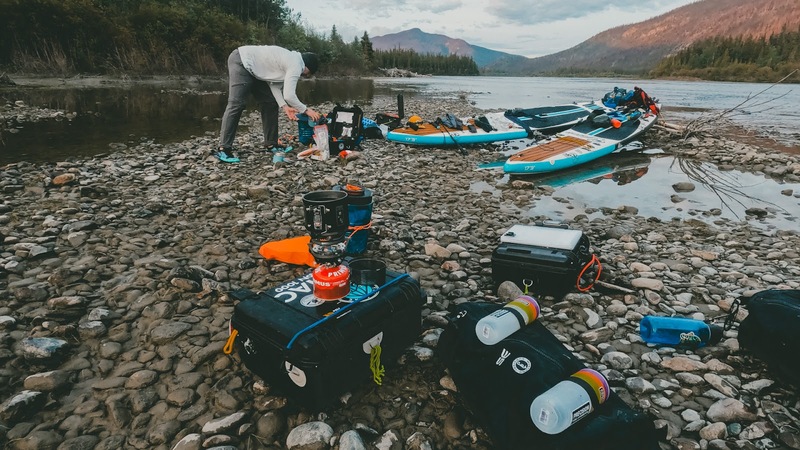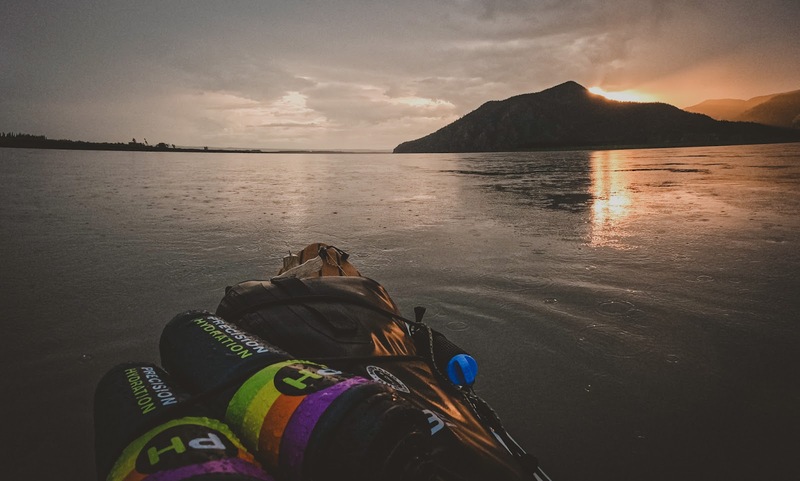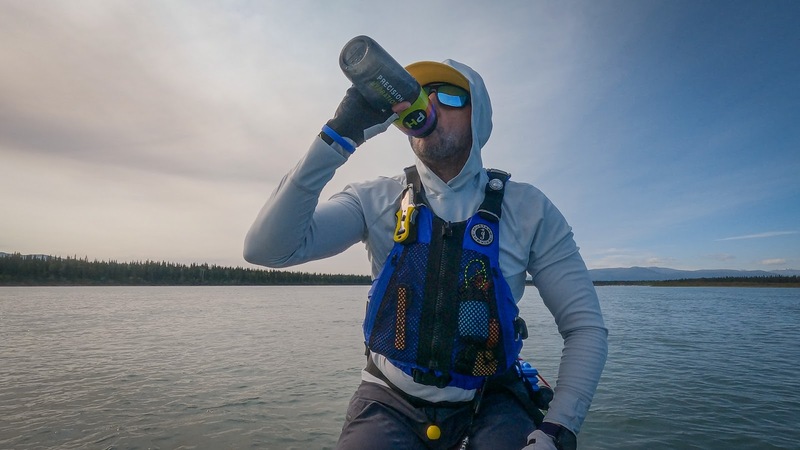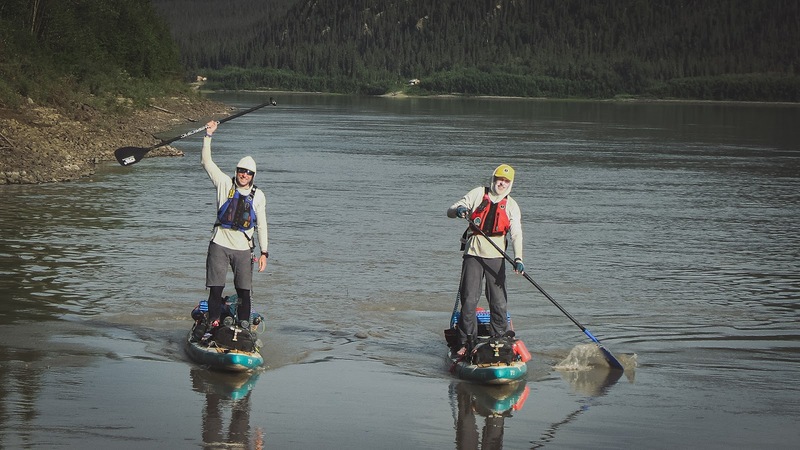The Yukon 1000 is the world's longest paddle race, covering a gruelling 1,000 miles from Canada to the Arctic Circle. Participants have 10 days to complete the race, and they're completely self-sufficient.
To help prepare for this epic challenge, Team Shac's Craig Sawyer and Skip Innes visited PF&H HQ in 2020 to get a Sweat Test. We discovered that Craig is a particularly salty sweater, losing more than 1,300mg of sodium per litre of sweat, whilst Skip loses 778mg/L.
The lads' plans were put on the backburner when the pandemic forced the postponement of the 2021 race, before Craig was forced to withdraw just a few days before the 2022 event when he tested positive for COVID.
They finally reached the start line in 2023 and it proved to be worth the wait...
Hi Craig! First up, how did it go???
We finished the race in 8 days, 13 hours and 3 minutes, and were the first Stand Up Paddleboard (SUP) team in. We made really good time as we reached the halfway cut-off point a day-and-a-half before the five-day cut-off.
Amazing, congratulations! Now, the Yukon 1000 has been billed as 'the world's most gruelling race' (and there's a risk of meeting local bears). So, how self-sufficient was the race?
The race is completely unsupported - you camp wild, you take all of your food with you and you make up water as you go. There are no two-way comms allowed - you have a tracker that sends your location to the organisers, and a satellite phone in a tamper proof bag for emergencies (using it will remove you from the race) - you are truly on your own!
You can paddle for up to 18 hours a day, with a mandatory six-hour stop that you must take starting at some point between 10pm and midnight (to give you a chance to find a safe place to pull in and camp).

On the first day, we spent ages looking for bear prints. From about day four onwards, we were so tired that we reduced that to a cursory glance for prints and straight into bed (with bear spray always close to hand!).
The six hours of rest basically involved:
- Checking site for suitability. Looking for fresh bear and moose tracks, scat, any signs that might suggest we wouldn't be alone...
- Securing the boards
- Moving all bear barrels and stuff with potential odours that bears could be interested in 100 metres downwind
- Putting up tents (we had two one-man tents)
- Tending to blisters etc
- Setting up water purification for the following day (basically filling a 10-litre collapsible container and mixing in a sachet of purification powder)
- Sleeping for around three hours
- Waking, and packing down camp, loading boards
- Transferring water from the 10-litre collapsible into various personal reservoirs and bottles
- Mixing PH Electrolyte Packets into some bottles
- Boiling water and making up food (freeze dried), and putting this into Hydraflask food containers to keep warm for later in the day
- Leave camp
And I understand the conditions were pretty unforgiving too?
For most of the race, it was hot and sunny. As the sun never really went down, there was no night time, so it just got warmer throughout the day. Temperatures were around 30°C (86°F) on average, and a bit hotter on a couple of days.
It only ever got cold (sub-10°C / 50°F) around 2-4am when we were in camp, plus some big storms on the last few days meant that temperatures would suddenly drop and we'd be drenched by heavy rain for an hour or so at a time.

We also had to be mindful that the river was cold; I fell in three times. Twice it was warm weather so I dried quickly and it was actually quite refreshing, but once I went in on an overcast, windy day and I had to get out of my clothes quickly and change into something dry.
How did you implement what you learned from your Sweat Test into your hydration strategy?
Following the Seat Tests we did back in February 2020, Skip has been using PH 1000 and, as the saltier sweater, I've been using PH 1500. For the race, we did face a challenge in that most of our hydration would be coming from a Lifestraw Go - essentially a one litre bottle we would fill from the river and then drink from through the purification filter.
We set up an eight-litre container full of water from the river each evening. We added purification powder and left it overnight. In the morning, we would pour the purified water through a muslin (which was actually our PH Adaptable Headwear!) and after all the residue was removed, we had around six litres of clean water.
We would then fill two PF&H Litre Bottles each, and add two PH tablets to each bottle.
We would also make a 500ml bottle with one PH 1500 tab and drink this immediately on waking. We would then sip throughout the day on our two litres of PH electrolytes.

Even though my dark leggings were white with salt by the end, I'm pleased to say that we didn't suffer any cramping.
Glad to hear it! And what did you eat to replace so many lost calories?
We knew it would be impossible to eat as much as we would burn - we had to take everything with us, so this meant finding food that was lightweight, would last up to 10 days and could be stored safely.
Food was a mix of freeze dried foods, and we'd have ~800kcal breakfasts and dinners. We would graze on the breakfast in the morning, and the dinner after lunch.
We made up our own trail mix with nuts and dried fruits, and put these in one litre drinks bottles with large neck openings so we could ‘drink’ the trail mix, which reduced the risk of getting food all over our clothes and boards which could attract wildlife when in camp.
We also had a PF 30 Gel before we set off each day, and topped up with two or three more during the day (plus I'd use the PF 30 Caffeine Gel); and we also had bags of sugary sweets, peanut butter and way too much beef jerky!
Flavour fatigue creeped in mid-way. We tried to make up daily food bags with variety but it all started to taste the same. We both discovered that we didn't actually enjoy beef jerky - it was tough and hard to chew on when tired.
Our food bags contained around 3,000 calories and we did our best to finish the day with them empty.
Eight days is a long time to spend with one other person. How did the teamwork element work during this challenge?
This worked really well - we had an agreement that if any little annoyances came up, we would address them immediately and not let anything fester. So, there were times when we would float along and I would raise an issue I had with Skip, or vice-versa, and we would discuss and deal with it there and then. This always meant we had clear air between us, which was important because issues can be blown out of proportion when fatigue and sleep deprivation sneak in.

And how's the recovery been?
We both lost pretty much all feeling in our feet and hands through temporary nerve damage. We could walk on fire and have no idea!
Four weeks later, it was more like pins and needles, feeling came back in most fingers, and thumbs are just a little numb. Otherwise, no other physical issues to report - I'm surprised at just how resilient our bodies can be!
I was back in the gym a week after the race, with some active recovery. Next up, I’m racing the 220km non-stop 11 Cities in Holland, and feeling strong and ready.
Amazing! Well done both! I'll leave our readers with some high-level stats from Craig's Garmin recording of the Yukon 1000...
| Yukon 1000 | |
|---|---|
| Distance Travelled | 1,000 miles |
| Total Time | 8 Days, 13 Hours, 3 mins |
| Total Paddle Strokes | 285,660 |
| Total Calorie Expenditure | 48,472 |
| Weight Loss | 5.8kg |